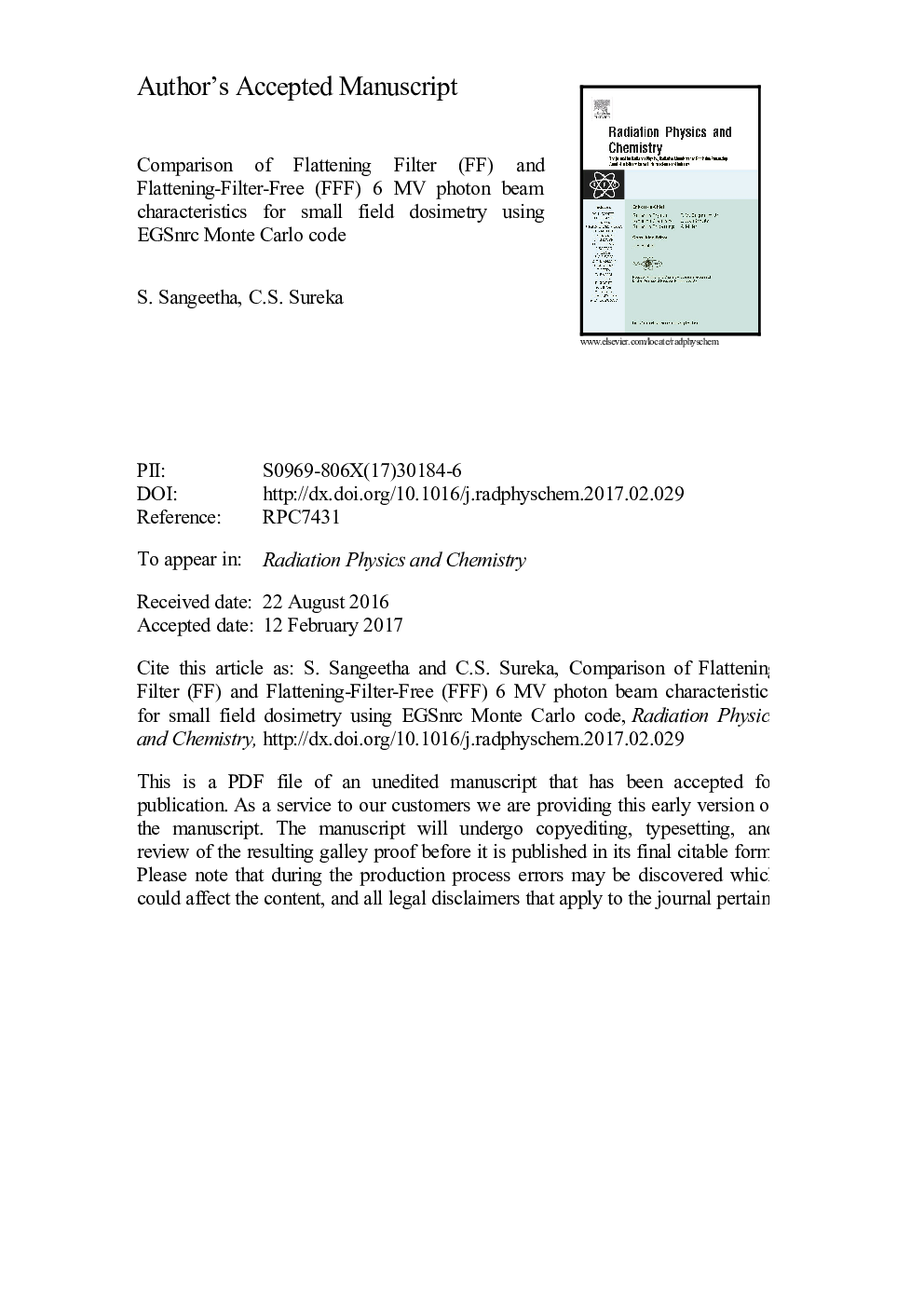| کد مقاله | کد نشریه | سال انتشار | مقاله انگلیسی | نسخه تمام متن |
|---|---|---|---|---|
| 5499220 | 1533489 | 2017 | 43 صفحه PDF | دانلود رایگان |
عنوان انگلیسی مقاله ISI
Comparison of Flattening Filter (FF) and Flattening-Filter-Free (FFF) 6Â MV photon beam characteristics for small field dosimetry using EGSnrc Monte Carlo code
دانلود مقاله + سفارش ترجمه
دانلود مقاله ISI انگلیسی
رایگان برای ایرانیان
موضوعات مرتبط
مهندسی و علوم پایه
فیزیک و نجوم
تشعشع
پیش نمایش صفحه اول مقاله

چکیده انگلیسی
The present study is focused to compare the characteristics of Varian Clinac 600Â C/D flattened and unflattened 6Â MV photon beams for small field dosimetry using EGSnrc Monte Carlo Simulation since the small field dosimetry is considered to be the most crucial and provoking task in the field of radiation dosimetry. A 6Â MV photon beam of a Varian Clinac 600Â C/D medical linear accelerator operates with Flattening Filter (FF) and Flattening-Filter-Free (FFF) mode for small field dosimetry were performed using EGSnrc Monte Carlo user codes (BEAMnrc and DOSXYZnrc) in order to calculate the beam characteristics using Educated-trial and error method. These includes: Percentage depth dose, lateral beam profile, dose rate delivery, photon energy spectra, photon beam uniformity, out-of-field dose, surface dose, penumbral dose and output factor for small field dosimetry (0.5Ã0.5Â cm2 to 4Ã4Â cm2) and are compared with magna-field sizes (5Ã5Â cm2 to 40Ã40Â cm2) at various depths. The results obtained showed that the optimized beam energy and Full-width-half maximum value for small field dosimetry and magna-field dosimetry was found to be 5.7Â MeV and 0.13Â cm for both FF and FFF beams. The depth of dose maxima for small field size deviates minimally for both FF and FFF beams similar to magna-fields. The depths greater than dmax depicts a steeper dose fall off in the exponential region for FFF beams comparing FF beams where its deviations gets increased with the increase in field size. The shape of the lateral beam profiles of FF and FFF beams varies remains similar for the small field sizes less than 4Ã4Â cm2 whereas it varies in the case of magna-fields. Dose rate delivery for FFF beams shows an eminent increase with a two-fold factor for both small field dosimetry and magna-field sizes. The surface dose measurements of FFF beams for small field size were found to be higher whereas it gets lower for magna-fields than FF beam. The amount of out-of-field dose reduction gets increased with the increase in field size. It is also observed that the photon energy spectrum gets increased with the increase in field size for FFF beam mode. Finally, the output factors for FFF beams were relatively quite low for small field sizes than FF beams whereas it gets higher for magna-field sizes. From this study, it is concluded that the FFF beams depicted minimal deviations in the treatment field region irrespective to the normal tissue region for small field dosimetry compared to FF beams. The more prominent result observed from the study is that the shape of the beam profile remains similar for FF and FFF beams in the case of smaller field size that leads to more accurate treatment planning in the case of IMRT (Image-Guided Radiation Therapy), IGAT (Image-Guided Adaptive Radiation Therapy), SBRT (Stereotactic Body Radiation Therapy), SRS (Stereotactic Radio Surgery), and Tomotherapy techniques where homogeneous dose is not necessary. On the whole, the determination of dosimetric beam characteristics of Varian linac machine using Monte Carlo simulation provides accurate dose calculation as the clinical golden data.
ناشر
Database: Elsevier - ScienceDirect (ساینس دایرکت)
Journal: Radiation Physics and Chemistry - Volume 135, June 2017, Pages 63-75
Journal: Radiation Physics and Chemistry - Volume 135, June 2017, Pages 63-75
نویسندگان
S. Sangeetha, C.S. Sureka,